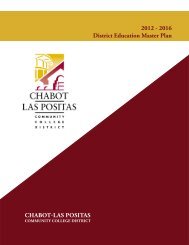City College of San Francisco - California Competes
City College of San Francisco - California Competes
City College of San Francisco - California Competes
Create successful ePaper yourself
Turn your PDF publications into a flip-book with our unique Google optimized e-Paper software.
STANDARD II.A<br />
Committee is the mainstay <strong>of</strong> this review<br />
process. Indeed, the mission <strong>of</strong> the <strong>College</strong><br />
Curriculum Committee is “to promote academic<br />
excellence and rigor by means <strong>of</strong> careful study<br />
and discussion and by the application <strong>of</strong> state<br />
regulations and policies <strong>of</strong> the District.” [Ref. 10]<br />
The Matriculation Office is also a part <strong>of</strong> this<br />
review process and ensures that all course<br />
prerequisites and co-requisites are reviewed<br />
and approved in conformance with applicable<br />
Title 5 requirements.<br />
Many departments partner with governmental<br />
agencies, community-based organizations, business,<br />
labor, and industry as well as prospective<br />
employers to develop and review instructional<br />
programs in order to ensure relevancy and quality.<br />
For example, the Business Department has<br />
worked with the Job Development Group to<br />
survey prospective employers to determine the<br />
skills these employers require <strong>of</strong> their employees.<br />
Student input is also sought by many departments<br />
through surveys in order to determine<br />
their needs and skill levels.<br />
The SCANS Project (described in more detail in<br />
the following section) and the Asian Infusion<br />
Project (now Multicultural Infusion) 9 also contribute<br />
to the quality <strong>of</strong> courses and programs<br />
by providing faculty innovative teaching strategies<br />
and course content that is culturally diverse.<br />
It should be noted that many faculty, both fulltime<br />
and part-time, are actively engaged in the<br />
subject matter they teach or are pr<strong>of</strong>essionals<br />
working in the field.<br />
With regard to the synthesis <strong>of</strong> learning within<br />
the instructional program, the institution<br />
increasingly uses data generated by the Office <strong>of</strong><br />
Research, Planning and Grants to make informed<br />
decisions regarding additions and modifications<br />
to the instructional program. These data include<br />
success, retention and persistence rates as well as<br />
institutional enrollment patterns, job placement<br />
and transfer rates. Some departments have gone<br />
an additional step and have developed curricula<br />
that integrate the resources <strong>of</strong> student service<br />
programs. For example, the Mathematics<br />
Department has developed a relationship<br />
with the Learning Assistance Center (LAC) that<br />
enhances the learning experience for its students.<br />
Peer tutorial sessions are provided by the<br />
LAC in which students tutor students in mathematics.<br />
Additional examples include the Bridge<br />
to Biotech Program that works with students<br />
as learning cohorts, internships, and work<br />
experience courses.<br />
II.A.2.d. The institution uses delivery modes and<br />
teaching methodologies that reflect the diverse<br />
needs and learning styles <strong>of</strong> its students.<br />
See response to Standard II.A.1.b. for details<br />
about delivery modes. With respect to teaching<br />
methodologies, all course outlines include<br />
reference to the instructional methodology<br />
employed. Typically, written exams and quizzes<br />
are used, although a variety <strong>of</strong> other methods,<br />
inclusive <strong>of</strong> journals, online assignments,<br />
research papers, group projects, presentations,<br />
demonstrations, and portfolios are also<br />
employed.<br />
The discussion <strong>of</strong> student needs, learning styles,<br />
and different teaching styles primarily occurs<br />
within the <strong>College</strong> community on an informal<br />
basis. Since Spring 2000, several FLEX Day workshops<br />
have addressed student learning styles<br />
(e.g., the Asian Infusion Project) and alternative<br />
teaching strategies (e.g., Service Learning).<br />
Perhaps the best evidence <strong>of</strong> the institution’s<br />
commitment to these issues is the Basic Skills<br />
Subcommittee which meets on a regular basis<br />
to discuss how faculty can improve their teaching<br />
<strong>of</strong> basic skills subjects (e.g., English, ESL,<br />
Mathematics, Transitional Studies, and Learning<br />
Assistance), as well as student learning styles.<br />
Those students with special learning needs or<br />
9 The Secretary’s Commission on Achieving Necessary Skills (SCANS) began with a series <strong>of</strong> initiatives launched by Secretary <strong>of</strong><br />
Labor Elizabeth Dole in November <strong>of</strong> 1989. Fundamentally, SCANS is intended to integrate eight basic skills into the curriculum,<br />
including five workplace skills and three personal qualities. At the time <strong>of</strong> this writing, SCANS is undergoing a transition<br />
to the Learning Outcomes/Learning Assessment Faculty Pr<strong>of</strong>essional Development Project (LOLA). The primary objective <strong>of</strong><br />
LOLA is to explore the use <strong>of</strong> assessment as a tool to improve student outcomes<br />
118 CITY COLLEGE OF SAN FRANCISCO







